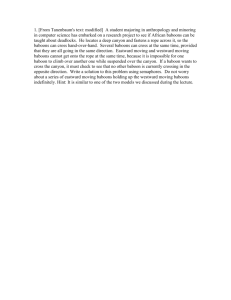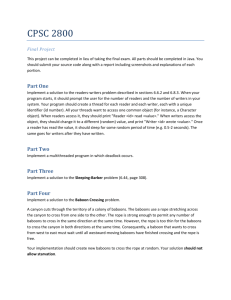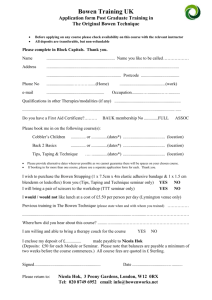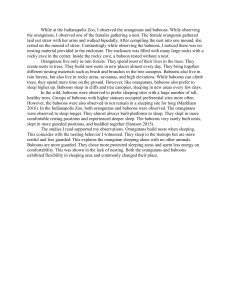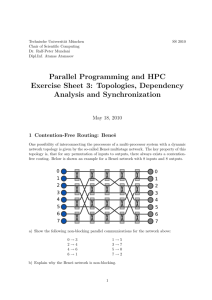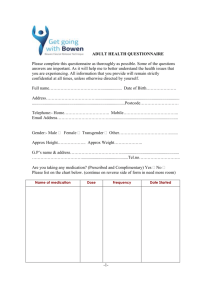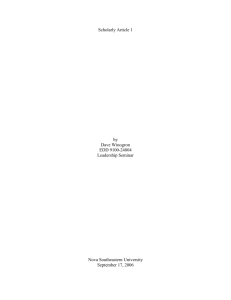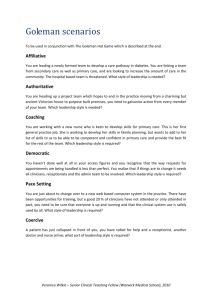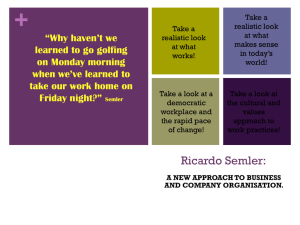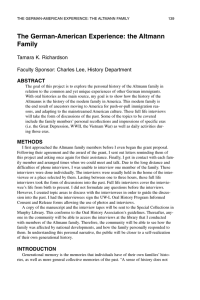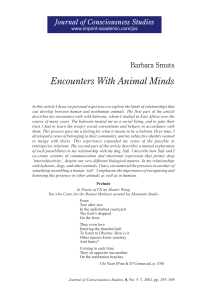Women and Leadership - Center for Family Consultation
advertisement
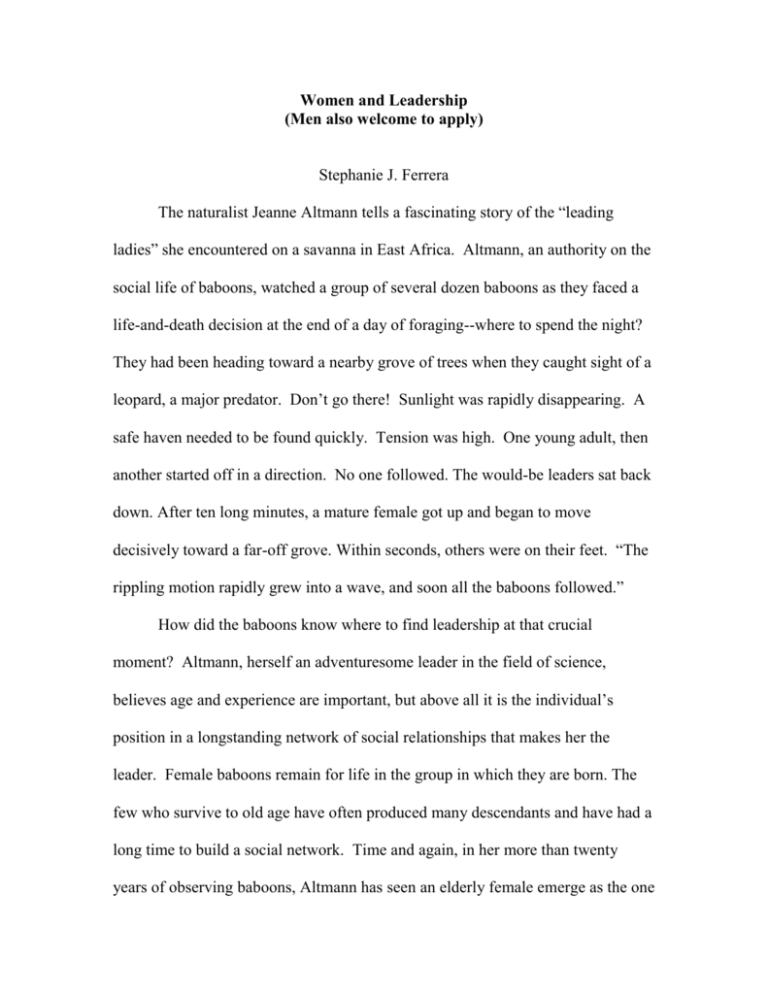
Women and Leadership (Men also welcome to apply) Stephanie J. Ferrera The naturalist Jeanne Altmann tells a fascinating story of the “leading ladies” she encountered on a savanna in East Africa. Altmann, an authority on the social life of baboons, watched a group of several dozen baboons as they faced a life-and-death decision at the end of a day of foraging--where to spend the night? They had been heading toward a nearby grove of trees when they caught sight of a leopard, a major predator. Don’t go there! Sunlight was rapidly disappearing. A safe haven needed to be found quickly. Tension was high. One young adult, then another started off in a direction. No one followed. The would-be leaders sat back down. After ten long minutes, a mature female got up and began to move decisively toward a far-off grove. Within seconds, others were on their feet. “The rippling motion rapidly grew into a wave, and soon all the baboons followed.” How did the baboons know where to find leadership at that crucial moment? Altmann, herself an adventuresome leader in the field of science, believes age and experience are important, but above all it is the individual’s position in a longstanding network of social relationships that makes her the leader. Female baboons remain for life in the group in which they are born. The few who survive to old age have often produced many descendants and have had a long time to build a social network. Time and again, in her more than twenty years of observing baboons, Altmann has seen an elderly female emerge as the one who “calls the shots.” (Reference: Altmann, J. “Leading Ladies” in Natural History, February 1992) Do the baboons have a lesson for us? Like them, do we humans choose our leaders based on strong relationships? If so, do women have an advantage? Is it possible that women, by virtue of the nurturing skills and attunement to others developed in their roles as mothers and caretakers, have a biological head start? In short, do women make better leaders? This is a hot topic in the business world these days. One recent article, “Women, it seems, are better bosses,” by Mark Sappenfield and Julie Finnin Day (Christian Science Monitor, January 15, 2001) states: Businesses want teambuilders and communicators—people who create a relationship with employees and instill in them a commitment to the organization. Studies have repeatedly shown that this means women. Five years ago, I joined with two partners, Carol Moran and Sydney Reed, to create the Women’s Leadership Institute. The three of us are social workers with years of experience consulting to families and work systems. We use our knowledge of human relationship systems to train and coach professional women in leadership. While we are pro-women, we are not anti-men. My own belief is that within-gender differences in leadership ability are greater than betweengender differences. Insofar as leadership depends on an individual’s level of maturity and ability to relate to people in collaborative, growth-producing ways, it is an “equal opportunity” pursuit. Both men and women are welcome to apply. 2 My partners and I are more than happy to share the knowledge of the Women’s Leadership Institute with men as well as women. Here are some of our best ideas. Our primary inspiration comes from the late Dr. Murray Bowen who was a psychiatrist at Georgetown University Medical School and a pioneer in the field of family systems. He describes the family leader as one who has the courage to define self, who is as invested in the welfare of the family as in self, who is neither angry nor dogmatic, whose energy goes to changing self rather than telling others what they should do, who can know and respect the multiple opinions of others. .” (Reference: Kerr, M. and Bowen, M. Family Evaluation. Norton, 1988. P. 342-3) This kind of family leader “is beyond the popular notion of power.” He or she automatically generates mature leadership qualities in others who follow. We also find the thinking of Daniel Goleman, author of Emotional Intelligence, to be on target. He writes in the Harvard Business Review, IQ and technical skills are important, but emotional intelligence is the sine qua non of leadership. Without it, a person can have the best training in the world, an incisive mind, and an endless supply of smart ideas, but still won’t make a great leader. Five qualities that Goleman sees as essential to EQ are self-awareness, selfregulation, motivation, empathy, and social skill. (Reference: Goleman, D. “What makes a leader?” Harvard Business Review, December 1998) It is one thing to describe mature, emotionally intelligent leadership, and another thing to operationalize it. Bowen, Goleman, and others have spelled out the basic principles. Here are a few of my favorites. First is: be aware of self and responsible for self. Goleman begins his book with a quote from Aristotle: 3 Anyone can become angry—that is easy. But to be angry with the right person, to the right degree, at the right time, for the right purpose, and in the right way—this is not easy. To know one’s own emotional landscape and its origins in one’s personal history, to know what triggers emotional reaction in oneself, to maintain a balance between thinking and emotion, to manage one’s emotions responsibly, and to use one’s emotions creatively in relating to others—this is Aristotle’s challenge. As we live and work with others, we have many impulses to dominate, coerce, lean upon, steer, blame, pity, undermine, and otherwise impinge on them. We have an equal number of opportunities to behave more responsibly. A high level of self-awareness has been reached when one is almost as sensitive to the way one is affecting others, as one is sensitive to the way others are affecting self. The second principle is: respect others as equals. Like many other species, we humans seem to be hierarchical by nature. We tend toward a dominantsubordinate mode of relating, especially when under stress. Equality is an ideal that inspires us but is not easy to practice. In a relationship of equals, differences are respected. Each person defines his or her view, listens respectfully to the other’s view, and does not pressure the other into agreement . We overcome the temptation to dominate and win through force, and we also overcome the temptation to hide out in the one-down subordinate position, to be silent and passive while others do all the thinking and take the responsibility. 4 Respect between equals is a guiding principle for Rev. Denise Griebler. a United Church of Christ pastor, who says, “The images for pastoral leadership that speak most profoundly to me are: midwife, coach, caller of a square dance, conductor of an orchestra or chorus. All of these images require a relationship of mutual respect between pastor, congregational leaders, and congregation.” The third principle follows from the first two. Discover the power of autonomy. Autonomy and freedom are cherished values, right up there with equality. One bold CEO, Ricardo Semler, states: “People, I’ve found, will act in their own best interests, and by extension, in their organizations’ best interests, if they’re given complete freedom.” (Reference: R. Semler, “How we went digital without a strategy.” Harvard Business Review. Sept-Oct. 2000) By sharing the control with his staff and encouraging their initiatives, Semler has seen his company, Semco, grow exponentially. His secret of success? Bring out the best in each individual while still working as a team. When people work together this way, there is a cross-fertilization of talent and ideas that is exciting, energizing, and highly productive. Autonomy begins at home. The great psychologist, Eric Erikson, defined the two-year-old as one who strives to gain control, who insists on choosing for self. Every parent knows the “no” stage, the “I do it myself” stage. Mature, adult autonomy means thinking and deciding for oneself, balanced with thoughtful consideration of the rights and welfare of others. Murray Bowen taught that “defining a self,” arriving at clear positions based on one’s own best thinking 5 about the issues, was what made one a leader. The “I-position” communicates to others,“This is where I stand; this is what I will and will not do.” Knowing where the leader stands leaves others clearer about their options. Carolyn Farrell, BVM, Associate Vice President of Loyola University and Director of the Gannon Center for Women and Leadership, has a position on leadership that incorporates all three of the above-mentioned principles, and then some: For me, leadership is not power over, rather, power with others. I strongly believe in the feminist principle of inclusiveness. This mode of operation may take time, but it builds ownership for the task at hand. Decision-making requires listening to others, gathering divergent opinions, and reflecting with others… . It requires the leader to make the final recommendation and to be accountable for such action. … Notable leadership also has the element of power within, an ethical stance or world view. (Reference: C. Farrell in “What is Leadership?” Loyola, Winter 1998.) In thinking about leadership at its best, I often refer to St. Paul’s vision of the community of individuals as he described it to the Romans. We are one body, made up of different individuals bringing different gifts. This vision--the diversity of gifts and the unity of spirit--was expressed in a little different way by Murray Bowen. He believed that an organization was at its best when it functioned as “a collection of individuals” as distinguished from “a group.” Group process, or the emotional reactivity among members, makes a group vulnerable to disruption or even disintegration if reactivity gets intense. In contrast, a collection of individuals is relatively free of emotional reactivity. In this calmer climate, interaction works to support individual thinking and functioning, to spur each 6 person to go further than he or she might go alone. (Reference: Ferrera, S. J. “Lessons from Nature on Leadership” in Comella, P., Bader, J., Ball, J.S., Wiseman, K. K., and Sagar, R. R., eds., The Emotional Side of Organizations. Washington, D.C., Georgetown Family Center, 1996) In a collection of individuals, the essence of leadership is calm presence and clear thinking. That may come from any member of the organization. This model of leadership, based on an understanding of human emotional systems, seems radically new in a world that still thinks of the leader as one who sits atop a chain of command. Yet how different is it from the “wisdom of the ages” taught years ago by St. Paul? Stephanie Ferrera is a clinical social worker in Oak Park, IL and faculty member of the Center for Family Consultation. 7
